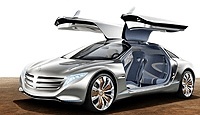Bold technology claims seemed to be order of the day at the Frankfurt Motor Show, but I left none the wiser as to what stage much of the R&D was at.
I was reporting from the Frankfurt Motor show this week, which the automotive industry would like us to believe is something of a comeback event — a return to form after some particularly trying years.
Indeed, many companies were keen to stress that research and development have continued apace (even if sales perhaps have not). And walking round the vast show there’s certainly lots of new toys on display.
I didn’t really pick up on any overriding themes from proceedings, but small, urban EVs certainly seem to be in vogue, with Audi, Volkswagen and Daimler (as a Smart) all offering up concepts. Maybe it’s a reflection of these more austere times; indeed, Audi’s effort is reminiscent of depression-era 1930s Auto Union racing cars.
Ambiguity
As a journalist focused on technology and innovation, the problem I faced is that Frankfurt is a rather glitzy affair and it’s often difficult to separate style from substance. This is especially true of the technology surrounding concept vehicles.
Clearly concepts are an essential part of the automotive design and development process. Without a completely open and imaginative ideas forum, we might still be stuck with 1930s technology.
But the process can run away with itself sometimes and design features and technology can feel a bit tacked-on – and worse, have no real functional basis in reality.
‘Technology for technology’s sake’ is how one of our readers, perhaps unfairly dismissed Land Rover’s concept, which is part of project to replace the Defender. I was a little taken aback at the feedback on the article, most of it sceptical, especially given that we are an innovation-led magazine.
But I do understand the cynicism. The 60-year-old Defender has iconic status and Land Rover itself admit that ‘replacing it is one of the biggest challenges in the automotive design world’.
Referring to the concept’s 3D terrain mapping feature, one reader pointed out that ‘most people can adequately map out the oncoming terrain in their heads!’ And that’s perhaps reflective of the feeling amongst devotees.
Jaguar
Meanwhile, sister company Jaguar revealed what it has tentatively labelled as the spiritual successor to another icon, the E-type, with the C-X16 — again met with derision from classic car aficionados.
Regardless of the naysayers, the concept is undeniably stunning and notably features some fancy kit in the guise of KERS-type ‘push to pass’ facility.
But you could be forgiven for being sceptical about Jaguar’s intentions for such technology.
The truly innovative, range-extending gas turbines - that appeared on last year’s C-X75 concept car - will not be on the version that enters production in 2013 (although Jaguar has not ruled out including them at some point in the future).
Daimler’s Mercedes-Benz
One particularly interesting concept at Frankfurt was Daimler’s Mercedes-Benz F124! research vehicle (yes, its name features an italicised exclamation mark) – intended as a celebration of the 125th year of the automobile.

It has a hydrogen tank and fuel cell as well as a lithium-sulphur battery powering an electric drivetrain that can achieve a range of 1000km. Now I’m not sure if that figure is plucked from thin air, but it appears in the ‘technical data’ of the press release along with more verifiable data such as wheelbase and kerb weight.
Also quoted here are the properties of the battery, which apparently has a energy density of 350Wh/kg and capacity of 10kWh. I’m told on good information that lithium sulphur cells are an extremely difficult prospect, still at the lab stage and will not be functional until at least 2020. Same goes for the hydrogen tank which apparently can store the fuel at ‘30 bar or less’ compared with the 700 bar of most tanks.
A press officer told me that these technologies were at various stages of development, but they could give me no indication as to whether that meant back-of-cigarette-pack jottings, laboratory tinkering, or full mechanical testing.
Now to be fair to Daimler, they also had in their stable a much more mature concept in the form of the Smart forvision, which aims to increase range through the use of more efficient materials.
BASF
I should state at this point that I was in Frankfurt to report on the forvision as a guest of BASF, the chemical company behind most of the material innovations on the concept.
Nevertheless, we were given a completely free reign and more importantly access to BASF’s research labs in nearby Ludwigshaven, which does help when it comes to verifying bold technology claims.
For example, in the lab we were shown scale model vehicles painted with BASF’s infrared-reflective coating (to keep the car cool), standing under identical lamps. Sensors showed an approximate 5˚C temperature difference, but we could also feel a noticeable difference by touching them. Not definitive proof of the paint’s superiority by any stretch, but something to grasp.
We also witnessed mechanical testing of one of the forvision’s wheels, which are claimed to be the first all-plastic, mass producible rims. Again, one test doesn’t mean that it’s roadworthy and the company admitted it will take another few years of testing and simulation. But there’s something a little more reassuring about seeing a hammer thwack into the thing from great height than read about it in a press release.
There is no doubt that many corporations – including all those mentioned here – do excellent world-class research. But a little more transparency at motor shows like Frankfurt and beyond might go a long way.




Report highlights significant impact of manufacturing on UK economy
I am not convinced that the High Value Manufacturing Centres do anything to improve the manufacturing processes - more to help produce products (using...